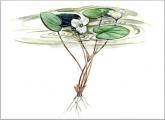Frogbit - Hydrocharis morsus-ranae
Free-floating water plant with free roots but which can root in the soil if water becomes scarce. Stolons up to 30 cm long with rooting nodes which can produce new rosettes.
Heartshaped leaves up to 6 cm wide with long stalk, arranged in rosettes spread open over the water surface. The shape and arrangement of the leaves make this little plant look like a miniature water-lily.
The Frogbit is a dioecious species with some individuals bearing male flowers and others female flowers; both forms have long stalks, three white petals and three green sepals. It flowers from June to September and is pollinated by insects.
Like other floating plants of stagnant waters, the Frogbit adopts an interesting strategy to survive the cold winter. At the tip of its stolons it produces special shoots called hiberacules; these become so heavy with the starch reserves they have accumulated, that when the mother plant dies, they sink to the bottom where the mud protects them from the frost.
In spring, when they have exhausted their starch supplies and have become lighter, the shoots surface and colonise the pond again. The Frogbit is widespread in marshes, ditches and bogs of Northern Italy and in peninsular Italy as far south as Campania . However it is rare everywhere due to land reclamation and eutrophication of the water.
Over the last few years it has no longer been seen at Tanali, Lake Sibolla and the Fucecchio Marshes. It can be considered a relict from the Terziary Era when the climate was hotter and wetter than it is today.




